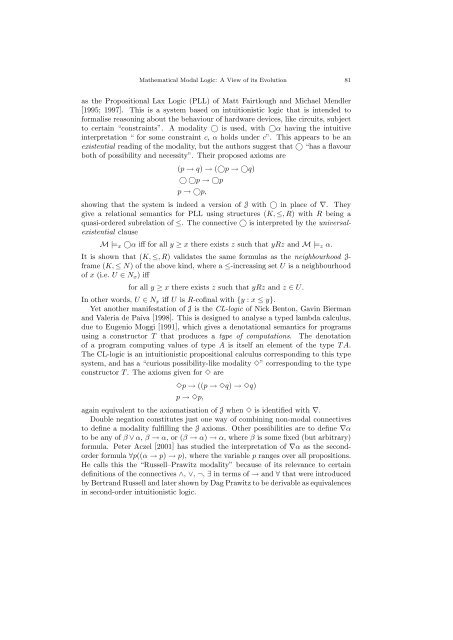MATHEMATICAL MODAL LOGIC: A VIEW OF ITS EVOLUTION
MATHEMATICAL MODAL LOGIC: A VIEW OF ITS EVOLUTION
MATHEMATICAL MODAL LOGIC: A VIEW OF ITS EVOLUTION
Create successful ePaper yourself
Turn your PDF publications into a flip-book with our unique Google optimized e-Paper software.
Mathematical Modal Logic: A View of its Evolution 81as the Propositional Lax Logic (PLL) of Matt Fairtlough and Michael Mendler[1995; 1997]. This is a system based on intuitionistic logic that is intended toformalise reasoning about the behaviour of hardware devices, like circuits, subjectto certain “constraints”. A modality ○ is used, with ○α having the intuitiveinterpretation “ for some constraint c, α holds under c”. This appears to be anexistential reading of the modality, but the authors suggest that ○ “has a flavourboth of possibility and necessity”. Their proposed axioms are(p → q) → (○p → ○q)○ ○p → ○pp → ○p,showing that the system is indeed a version of J with ○ in place of ∇. Theygive a relational semantics for PLL using structures (K, ≤, R) with R being aquasi-ordered subrelation of ≤. The connective ○ is interpreted by the universalexistentialclauseM |= x ○α iff for all y ≥ x there exists z such that yRz and M |= z α.It is shown that (K, ≤, R) validates the same formulas as the neighbourhood J-frame (K, ≤ N) of the above kind, where a ≤-increasing set U is a neighbourhoodof x (i.e. U ∈ N x ) ifffor all y ≥ x there exists z such that yRz and z ∈ U.In other words, U ∈ N x iff U is R-cofinal with {y : x ≤ y}.Yet another manifestation of J is the CL-logic of Nick Benton, Gavin Biermanand Valeria de Paiva [1998]. This is designed to analyse a typed lambda calculus,due to Eugenio Moggi [1991], which gives a denotational semantics for programsusing a constructor T that produces a type of computations. The denotationof a program computing values of type A is itself an element of the type T A.The CL-logic is an intuitionistic propositional calculus corresponding to this typesystem, and has a “curious possibility-like modality ✸” corresponding to the typeconstructor T . The axioms given for ✸ are✸p → ((p → ✸q) → ✸q)p → ✸p,again equivalent to the axiomatisation of J when ✸ is identified with ∇.Double negation constitutes just one way of combining non-modal connectivesto define a modality fulfilling the J axioms. Other possibilities are to define ∇αto be any of β ∨ α, β → α, or (β → α) → α, where β is some fixed (but arbitrary)formula. Peter Aczel [2001] has studied the interpretation of ∇α as the secondorderformula ∀p((α → p) → p), where the variable p ranges over all propositions.He calls this the “Russell–Prawitz modality” because of its relevance to certaindefinitions of the connectives ∧, ∨, ¬, ∃ in terms of → and ∀ that were introducedby Bertrand Russell and later shown by Dag Prawitz to be derivable as equivalencesin second-order intuitionistic logic.
















